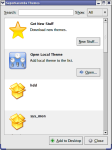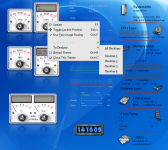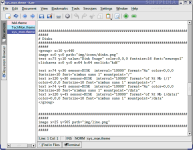Widgets are more and more popular nowadays and interesting alternatives are starting to show up on Linux too. SuperKaramba is probably the first software for using widgets on your desktop and initially was a system monitoring application. It was slowly developed over the years, but the community around it grew gradually, many themes appeared and now it is considered a part of KDE.
First time I used SuperKaramba or Karamba (I don't remember which one it was at that time), I was amazed by the way I managed to make the desktop look. My Linux desktop looked like a computer from a SciFi movie. Today I rarely use it because I don't have the time to make everything look and work just right and because I get impressed a lot harder.
When I say time you'll probably think that I'm exaggerating a little, but to make SuperKaramba look cool and be functional in the same time you need at least an hour to waste, an eye for aesthetics and a little more than basic Linux skills if you want your widgets to work as they should.
The design of SuperKaramba gives it many advantages, such as themes that come in various shapes and sizes and which perform a lot of different tasks. Unfortunately there is an important disadvantage as well - SuperKaramba generally doesn't work right "out of the box".
This software is popular for displaying system information on your Linux desktop and for doing it in style. I never thought of it as a widgets application, but, in fact, it can be considered as such. Most themes are for monitoring the system; others are for displaying the weather forecast, for controlling different multimedia applications and a lot more.
The engine is built upon Python, which brings other advantages. Python is an easy to comprehend language and if a theme is documented enough, everyone can customize it to make their own. There is a small downside of using python and this is that you actually need it installed to be able to run SuperKaramba. Fortunately, these days, dependencies can be satisfied easily and it's actually nice to have python because chances of finding other interesting applications that use it are pretty high.
You might ask yourself what are the things that SuperKaramba does out of the box. The answer is: not much. It has no default themes (widgets) that you can use and when you start it there isn't much to see. When you click its icon that's docked in the system tray, a themes window appears but with no themes. Instead it has two buttons, one for getting new themes form the Internet and another for opening a local theme. Adding this Internet feature is pretty cool because now it's easier than ever to install themes. If I were you I'd check out the kde-look.org website because there it's very likely you'll find a lot more stuff for SuperKaramba and, why not, for your KDE desktop.
This software has various ways of displaying information about the CPU load, memory load, disk usage, network load, fans, temperature, e-mail, weather and so on. These ways of displaying all those things can be combined with graphics designed by different users and the result will be a vast amount of very different themes.
If at some point you are considering to design your own theme, reading the documentation about all the parameters is crucial. Using some examples will definitely help because it greatly accelerates the speed of understanding how this software works. I'm telling you all this because SuperKaramba wasn't designed to be configured from an interface, but from a fairly complex text file.
While playing with it for the purpose of this review I found a severe bug. If you modify a theme while it is opened, the system will become unusable because SuperKaramba will use up all the resources of your PC. I remember this bug wasn't present in earlier versions but I do remember that modifying a theme was a lot easier because right-clicking on it would show up an edit theme button.
Once opened and set-up, SuperKaramba will automatically start in the last state you left it. This is very good because it saves you from having to create a script that does that.
The Good
SuperKaramba is versatile and provides eye candy to the KDE desktop while still being able to be a functional software. A desktop with a proper setup of SuperKaramba was a cool desktop a few years ago when few people used it and still is today .
The Bad
This software is by no means easy to use and unfortunately still has some major bugs. For an application that doesn't actually do something important maybe it needs a little too much processing power. However, considering the specs of today's average computer, I don't think this should be an issue for most of you.
The Truth
SuperKaramba is a very nice application for the desktop, and when I found out it was included in KDE I made a happy face. Analyzing the facts a little better I'm not sure it deserves it, but then again I'm not sure it doesn't. It's perhaps a little too complicate to fit in KDE's "ease of use" philosophy but maybe this way things would start developing faster and when KDE4 reaches release date with all the cool things like real transparency we'll have a much better SuperKaramba. After all it's a pretty interesting piece of software.
Check out some screenshots below:
 14 DAY TRIAL //
14 DAY TRIAL // 





